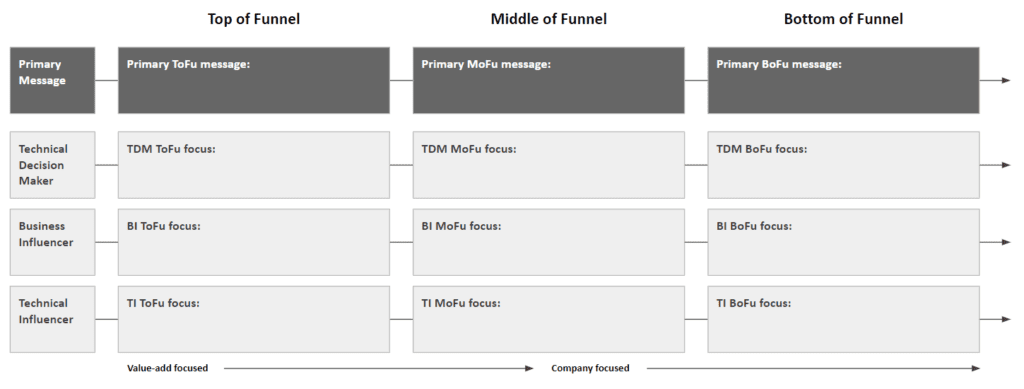Best Practices to Identify and Engaging Your B2B Target Audience

By Josh Baez, Engagement Manager at Heinz Marketing
As B2B marketers, understanding our target audience is essential to every single thing twe do. Our audience influences the content we create, the messaging we write, the products we help bring to market — everything. And without a clear sense of who we’re targeting and why we’re targeting them, the work we’re doing is little more than random acts of marketing — screaming product pitches into the void hoping that someone, somewhere, answers back.
Yet all too often organizations lack the necessary details around their target audience to be able to actually do anything meaningful, leaving marketing teams to fend for themselves when it comes time to “launch a campaign,” and audiences overwhelmed with woefully underwhelming marketing experiences.
As an agency marketer, this situation is even harder to get out of. That situation where all we have to go off of are titles — maybe there’s some information about industries — but there’s definitely nothing around psychographics, focus areas, or even pain points of the people we’re tasked to market to.
The common mistake that organizations make when it comes to identifying their target audience is assuming that these people want to hear about the product, when, in fact, a majority of them don’t.
Successful marketing requires a gap to be bridged — a gap between those people who want to hear about the product and those who don’t, let alone those who aren’t even aware they have a problem that requires a solution to begin with.
The question is: How can organizations begin to bridge those gaps?
Here are three key areas to help you better identify, develop, and engage your target audience so you can more effectively and consistently drive pipeline for your organization.
- DEFINE your ideal customer profile
- DEVELOP your personas
- MAP your target audience’s challenges and needs across the buyer’s journey
DEFINE your ideal customer profile
The first step to develop your target audience is to define your ideal customer profile. This exercise is to help you really narrow down who, ideally, you want to target. It will also help to ensure you’re actually going after the right people in the right accounts with the right materials, messages, and offers.
Consider the following criteria to get you started —
- General Firmographics: these are your typical criteria that most LinkedIn profiles, or even Google searches, will provide.
- Geography
- Industries
- Annual revenue
- Company size
- Required titles in the company
- Specific Firmographics: these qualities are more specific based on your company’s products and services. For this example, let’s assume we’re building an ideal customer profile for a technology company. What more specific profile details would a technology company need within an ideal target account?
- IT budget: of course, a technology company would want to make sure their ideal target account actually has budget for their solution
- Technology requirements: an ideal account would also be invested in the right technology, or at the very least, a baseline set of technologies, that could indicate traits like organizational maturity or a willingness to grow.
- Situational Criteria: these criteria are based around potential situations that have recently happened within an ideal target account. We’ll continue to use a technology company as an example to identify potential scenarios that could indicate a good account.
- Leadership change: if there has been a leadership change within the organization, it may present an opportunity to reach out and determine if there are areas that need extra coverage or support.
- Recent data breach: a company who’s just suffered a data breach is likely rethinking their entire technology structure, and that presents a perfect opportunity for a technology company to throw their name in the ring.
There are, of course, other criteria you could include in your ideal customer profile. The key here is to ensure that whatever criteria you do decide on using helps you build out a more robust depiction of the accounts you’re going after so you can better target and market to them.
DEVELOP your personas
Persona development is the next key factor in building your target audience framework. These personas should go well-beyond simple titles and job descriptions, encompassing details around psychographics, role in the buying decision, internal and external influences, and pain points.
Typically, we like to organize our personas into three roles determined by their titles:
- Decision Makers: the end-all of the decision — typically C-Suite or VP level.
- Champions: the person within the target account who helps rally the buying committee — typically director level.
- Influencers: the end-user of the solution — this is the person who is using the product or service day-to-day.
And, if you want to get even more specific, you can further break these three roles into focuses:
- Business-focused: meaning that the persona is more focused on strategy, outcomes, and the overall value the solution provides to the business.
- Technically-focused: meaning that the persona is more focused on the technical aspects of the solution — what it does, how, and what they get out of it.
And now, it’s time to tie these all together with title information, goals, pain points, etc. Here is the criteria we typically utilize when developing our personas:
- Internal influences: who within the company has influence over this persona’s decision making?
- External influences: what external forces could influence this persona’s decision making?
- Job focus areas: what is this persona responsible for within their organization?
- Attitude and reputation: how does the industry typically perceive this persona? Are they technically-savvy? Business-oriented? Skeptical of new solutions? Are they on the line for revenue?
- Business goals: what does this persona hope to achieve in their role?
- Pain points: what does this persona struggle with when attempting to achieve their goals?
- Use cases for the solution: what are some use cases where the persona would utilize and benefit from your solution?
MAP your target audience’s challenges and needs across the buyer’s journey
Lastly, it’s time to map your target audience’s challenges and needs across the buyer’s journey. This is likely going to be the most challenging step of the three, as it requires you have a detailed understanding of who your target audience is, what they care about, and how they make decisions.
This piece is all about mapping your personas’ needs, challenges, and focus areas to each stage of the buyer’s journey. You can see in the example below a framework of how we typically do this:
Along the top, you see columns for the top, middle, and bottom of the funnel. These columns will each house specific messaging as it relates to those three core buying stages.
The first row, in dark grey, is your primary message. Putting your personas aside for a moment, what are you ultimately trying to say at each of these buying stages? What is the primary message you’re trying to get across from awareness to consideration to decision?
As you go down the lighter-grey rows, you’ll want to input your key personas. These rows are designed to take your primary messages at each stage and boil them down so they are relevant to the personas you want to address.
And, as you move from left to right, you will start to be more product-focused.
In doing this, you’ll be able to more consistently identify what you want to talk about and how you want to talk about it with each persona as they move from the top of the funnel to the bottom:
- Top of Funnel: the top of the funnel is designed to generate awareness for a need and should be completely product-agnostic. Identify the challenges that you’re addressing, the benefits that your solution provides, and the outcomes that your users achieve — but without ever addressing your solution.
- The goal of this stage is to get the lead to be aware that they have a problem to begin with — identifying that they could be doing more if not for the seen and/or unseen hindrances that are holding them back.
- Middle of Funnel: at the middle of funnel, your lead is aware there’s a problem and they are actively looking for a solution. This is the consideration stage of the buyer’s journey, and here is where you can start sprinkling in more specific tie-ins to your company.
- The goal of this stage is to get the lead to consider your solution — do what you can to continue the messaging from the top of the funnel and tie in more specific benefits of using a solution like yours (without being too heavy handed).
- Bottom of Funnel: at the bottom of the funnel is when you can be very specific about your solution and what it will bring to the table. Here is where you can mention, more specifically, your features and benefits as they relate to your prospect’s overall pain points.
- The goal of this stage is to get the lead to decide that your solution is the right solution. Reinforce what your organization can do to enhance what they’re doing now and help them accomplish even more in the future.
Developing your target audience may seem like a lot to consider — and from an ideal customer profile to personas to an entire messaging framework — there are undoubtedly a lot of moving parts. But these pieces, while time-consuming, are essential to your success as a marketer. This level of detail will influence everything you do, and will allow you to be smarter, more thoughtful, and more strategic about what you’re doing and how you’re doing it.
